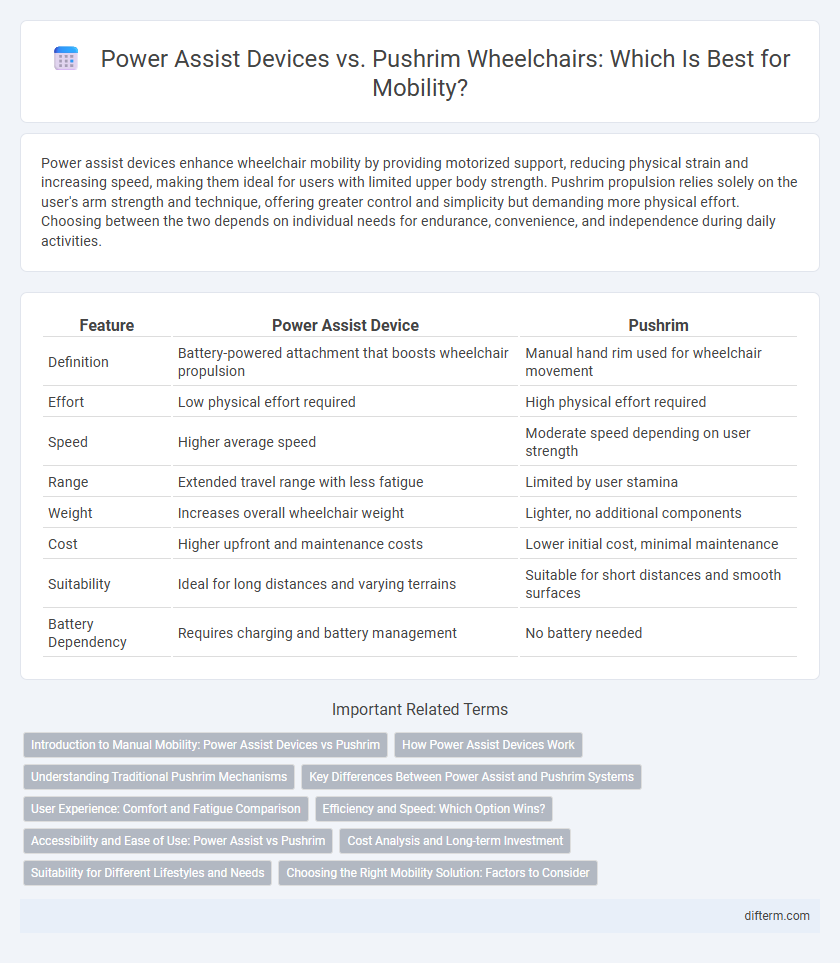Power assist devices enhance wheelchair mobility by providing motorized support, reducing physical strain and increasing speed, making them ideal for users with limited upper body strength. Pushrim propulsion relies solely on the user's arm strength and technique, offering greater control and simplicity but demanding more physical effort. Choosing between the two depends on individual needs for endurance, convenience, and independence during daily activities.
Table of Comparison
| Feature | Power Assist Device | Pushrim |
|---|---|---|
| Definition | Battery-powered attachment that boosts wheelchair propulsion | Manual hand rim used for wheelchair movement |
| Effort | Low physical effort required | High physical effort required |
| Speed | Higher average speed | Moderate speed depending on user strength |
| Range | Extended travel range with less fatigue | Limited by user stamina |
| Weight | Increases overall wheelchair weight | Lighter, no additional components |
| Cost | Higher upfront and maintenance costs | Lower initial cost, minimal maintenance |
| Suitability | Ideal for long distances and varying terrains | Suitable for short distances and smooth surfaces |
| Battery Dependency | Requires charging and battery management | No battery needed |
Introduction to Manual Mobility: Power Assist Devices vs Pushrim
Manual mobility solutions include pushrim wheelchairs, which rely entirely on user strength for propulsion, and power assist devices, which amplify the user's input to reduce physical effort. Power assist technology integrates motorized components with traditional pushrim systems, improving speed and endurance without sacrificing control. Understanding the differences in force application, user fatigue, and maneuverability is crucial for optimizing mobility and independence.
How Power Assist Devices Work
Power assist devices use integrated sensors and motors to detect and amplify the user's push force on the wheelchair rims, effectively increasing propulsion efficiency and reducing physical strain. These systems convert manual input into controlled motorized assistance, adapting in real-time to varying terrain and user effort. By enhancing mobility through smart power augmentation, power assist devices improve endurance and independence for wheelchair users compared to traditional manual pushrims.
Understanding Traditional Pushrim Mechanisms
Traditional pushrim mechanisms rely on direct hand contact with the wheelchair's outer rims, requiring users to exert significant upper body strength and coordination for propulsion. These systems often lead to repetitive strain injuries due to the high physical demand and inefficient energy transfer during movement. Conversely, power assist devices reduce the effort needed by amplifying users' input through motorized support, enhancing mobility while preserving the user's control and independence.
Key Differences Between Power Assist and Pushrim Systems
Power assist devices enhance manual wheelchairs by providing motorized support to the pushrims, reducing user effort and improving mobility for those with limited strength, while traditional pushrim systems rely solely on manual propulsion through direct hand contact with the rims. Power assist systems often include sensors that detect hand movement and adjust motor power accordingly, enabling smoother acceleration and less fatigue. Pushrim systems offer simplicity and lower maintenance but may increase strain on the shoulders and arms during extended use or over rough terrain.
User Experience: Comfort and Fatigue Comparison
Power assist devices significantly reduce user fatigue by amplifying propulsion force, resulting in smoother, less strenuous movement compared to traditional pushrims. Enhanced ergonomic design and motorized assistance improve overall comfort, minimizing repetitive strain on shoulders and wrists during long-term wheelchair use. Users report increased endurance and decreased physical exertion, making power assist devices a superior choice for maintaining mobility with reduced discomfort.
Efficiency and Speed: Which Option Wins?
Power assist devices significantly enhance efficiency and speed compared to traditional pushrims by reducing the physical effort required for propulsion. These devices integrate electric motors that amplify user input, resulting in faster acceleration and smoother navigation over varied terrains. Studies show power assist devices can increase travel speed by up to 30% while decreasing user fatigue, making them a superior choice for mobility efficiency and performance.
Accessibility and Ease of Use: Power Assist vs Pushrim
Power assist devices enhance wheelchair mobility by reducing the physical effort required, making them highly accessible for users with limited upper body strength. Pushrim wheelchairs rely on manual propulsion, which can be challenging for users with reduced endurance or arm function. Power assist technology provides smoother acceleration and easier navigation, significantly improving ease of use compared to traditional pushrims.
Cost Analysis and Long-term Investment
Power assist devices typically involve higher upfront costs compared to traditional pushrims but offer significant long-term savings by reducing user fatigue and minimizing the risk of repetitive strain injuries. Pushrims are more affordable initially but may lead to increased healthcare expenses over time due to the physical strain they impose on users. Investing in power assist technology enhances mobility efficiency and durability, potentially lowering maintenance costs and improving overall user quality of life.
Suitability for Different Lifestyles and Needs
Power assist devices enhance mobility by providing motorized support, making them ideal for users with limited upper body strength or those navigating hilly terrains. Pushrim wheelchairs rely on manual propulsion, offering greater control and fitness benefits suited for active individuals or those preferring a more traditional approach. Selecting between these options depends on lifestyle demands, physical capabilities, and the desired balance between independence and effort.
Choosing the Right Mobility Solution: Factors to Consider
Selecting the right mobility solution involves evaluating key factors such as user strength, endurance, and daily activity levels. Power assist devices enhance propulsion efficiency and reduce fatigue by providing motorized support to manual wheelchairs, ideal for individuals with limited upper body strength. Pushrim wheelchairs offer greater control and agility for users with sufficient arm strength, making them suitable for those seeking independence and active lifestyles.
Power assist device vs Pushrim Infographic

 difterm.com
difterm.com